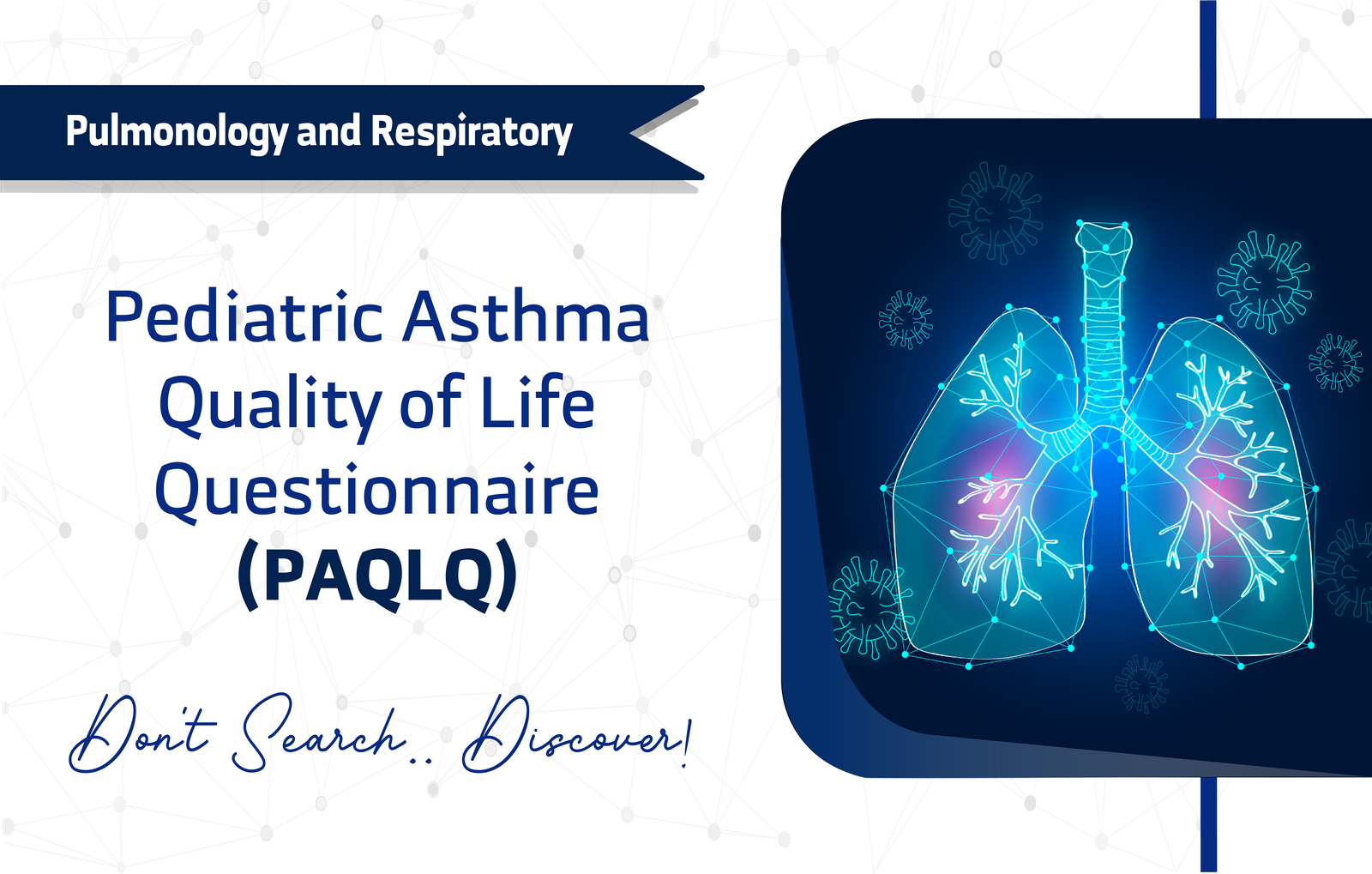Introduction
Developed by Elizabeth Juniper in 1996, the Pediatric Asthma Quality of Life Questionnaire (PAQLQ) is a leading tool for assessing how asthma affects the daily lives of children aged 7–17. With over 1,000 citations on Google Scholar, its widespread use underscores its reliability and relevance. For instance, its child-centered design makes it ideal for pediatric clinics. Consequently, this article provides researchers and clinicians with a comprehensive overview of the PAQLQ’s features, applications, and clinical value, equipping them with insights to advance pediatric asthma research and care.
Key Features of the Pediatric Asthma Quality of Life Questionnaire
Purpose and Use of the Pediatric Asthma Quality of Life Questionnaire
The PAQLQ evaluates asthma’s impact on children’s quality of life, focusing on symptoms, emotional functioning, and activity limitations. Clinicians use it for monitoring and treatment planning, while researchers employ it in clinical trials and epidemiological studies. For example, its emphasis on patient-prioritized activities helps tailor interventions, enhancing asthma management in pediatric populations.
Target Population
The PAQLQ targets children and adolescents with asthma:
- Children (7–12 years).
- Adolescents (13–17 years).
Thus, it suits pediatric clinics and research settings, ensuring relevance for young patients. Additionally, an interviewer-administered version supports younger children, broadening its applicability.
Structure of the Pediatric Asthma Quality of Life Questionnaire
Published by McMaster University, the PAQLQ comprises 23 items, including 13 activity-based and 10 symptom/emotional questions under the following sub-domains:
- Symptoms (e.g., wheezing, coughing)
- Emotional Functioning (e.g., frustration, fear)
- Activity Limitations (e.g., sports, play).
For activity items children select 3–5 important activities affected by asthma, and for symptom/emotional items they rate frequency/severity of asthma impacts (e.g., “How bothered were you by coughing?”), rating their impact on a 7-point Likert scale (1 = extremely bothered, 7 = not bothered). As a result, it captures asthma’s multidimensional effects efficiently.
Scoring Method
Each PAQLQ item is scored from 1 to 7, with higher scores indicating better quality of life. Researchers calculate a total score as the mean of all items, alongside separate means for symptoms, emotions, and activities domains.
A minimal clinically important difference (MCID) of 0.5–1.0 points change guides interpretation. For instance, a 1-point improvement may signal meaningful treatment response. Therefore, the scoring system supports precise clinical and research analysis.
Administration Format of the Pediatric Asthma Quality of Life Questionnaire
The PAQLQ is available in different formats offering flexibility:
- Paper-based forms.
- Digital (Online) platforms.
- Interviews (in person).
The PAQLQ is primarily self-administered but may require basic training for younger children or interviewers. It takes 10–15 minutes to complete.
Applications of the Pediatric Asthma Quality of Life Questionnaire
The PAQLQ serves critical roles in pediatric asthma management:
- Monitoring: Tracks changes in asthma’s impact over time, particularly during treatment.
- Treatment Planning: Guides therapy adjustments based on PAQLQ scores, prioritizing significant impacts.
- Research: Supports clinical trials evaluating asthma interventions, advancing evidence-based pediatric care.
For example, a low activity domain score may prompt a clinician to adjust therapy, while researchers analyze quality-of-life trends.
Languages and Availability
To support global use, the PAQLQ is available in several languages, including:
- English
- Spanish
- French
- German
- Dutch
This multilingual accessibility enhances its utility in diverse clinical and research contexts.
Reliability and Validity
The PAQLQ demonstrates high reliability, with a Cronbach’s alpha of 0.88–0.95, reflecting strong internal consistency (Juniper et al. (1996)). Validation studies confirm its efficacy across pediatric asthma populations, ensuring robust psychometric properties. Moreover, its sensitivity to changes in asthma impact makes it a trusted tool for monitoring outcomes.
Cost and Licensing of the Pediatric Asthma Quality of Life Questionnaire
The PAQLQ is free for non-commercial use under an open-access license. For inquiries, contact McMaster University’s Department of Clinical Epidemiology at info@mcmaster.ca.
Related Questionnaires and Other Versions
Researchers and clinicians may find it useful to be aware of other questionnaires that are similar or complementary to the PAQLQ, such as:
- c-ACT: Childhood Asthma Control Test.
- PACQLQ: Pediatric Asthma Caregiver’s Quality of Life Questionnaire.
Additionally, other versions of the PAQLQ exist, including:
- There is an Interviewer-administered version for younger children.
These related instruments provide additional options for researchers studying asthma across different populations.
Limitations and Considerations
However, despite its strengths, the PAQLQ has a few limitations:
- Self-report measure: Respondents may be influenced by social desirability bias or personal interpretation.
- Cultural Bias: Some activities may not resonate universally, affecting accuracy in certain populations.
- Language Barriers: Limited language options may restrict use in non-supported regions.
Additional Resources
For further exploration, consider these resources:
- Original Validation Study: Juniper et al. (1996)
- For inquiries, contact McMaster University’s Department of Clinical Epidemiology at info@mcmaster.ca or visit the website here.
- For further information GINA Guidelines (references ACT for asthma control monitoring) and American Thoracic Society (ATS) resources.
Frequently Asked Questions (FAQ)
- Who can use the PAQLQ?
Clinicians, researchers, and healthcare providers use the PAQLQ for children aged 7–17 with asthma. - How long does it take to complete the PAQLQ?
Patients typically take 10 to 15 minutes to complete the PAQLQ, feasible for clinical and research settings. - How is the PAQLQ administered?
Healthcare teams administer the PAQLQ via paper, digital, or interview formats, offering flexibility in usage. - Is there any cost to using the PAQLQ?
The PAQLQ is free for non-commercial use. For commercial or funded academic projects, permission from McMaster University at info@mcmaster.ca may be necessary.
A word from ResRef about the Pediatric Asthma Quality of Life Questionnaire
The PAQLQ is the gold standard for measuring asthma’s impact on children’s lives, combining rigor with child-friendly design. Whether you are a researcher evaluating disease impact or a clinician improving patient care, the PAQLQ reveals critical areas that need attention. Consequently, it leads to better outcomes and informed treatment decisions.
References
- Juniper EF, Guyatt GH, Feeny DH, Ferrie PJ, Griffith LE, Townsend M. Measuring quality of life in children with asthma. Qual Life Res. 1996 Feb;5(1):35-46. doi: 10.1007/BF00435967. PMID: 8901365. Study link.
- Poachanukoon O, Visitsunthorn N, Leurmarnkul W, Vichyanond P. Pediatric Asthma Quality of Life Questionnaire (PAQLQ): validation among asthmatic children in Thailand. Pediatr Allergy Immunol. 2006 May;17(3):207-12. doi: 10.1111/j.1399-3038.2005.00349.x. PMID: 16672008. Study link.








